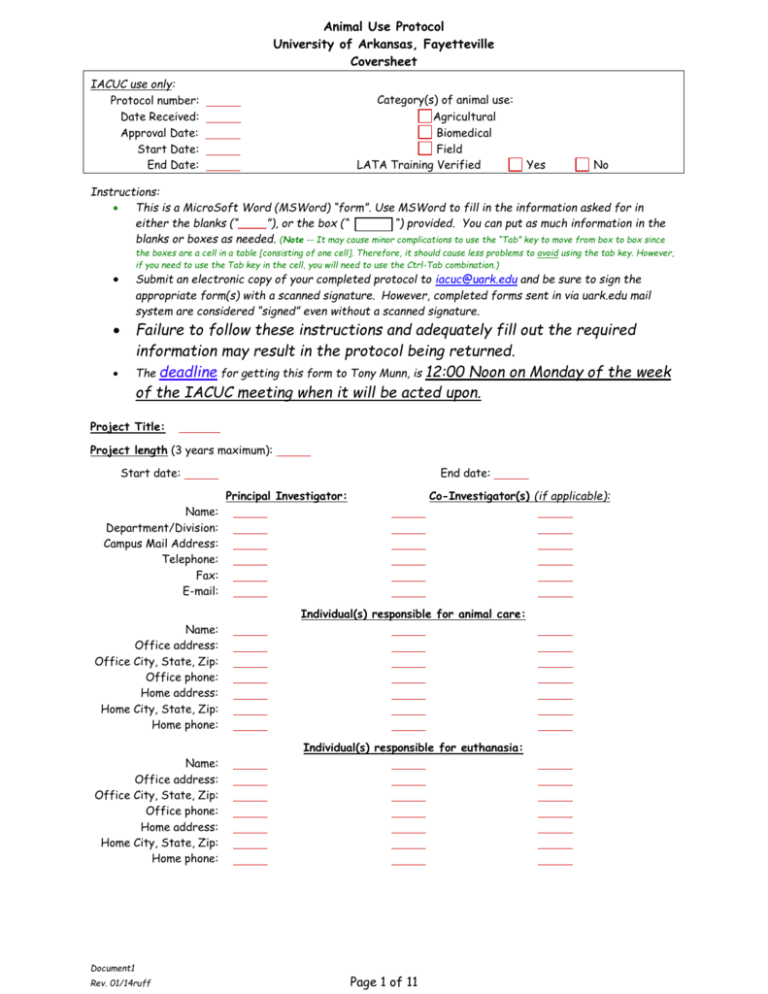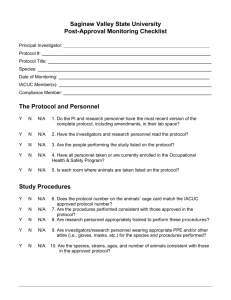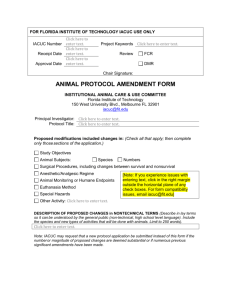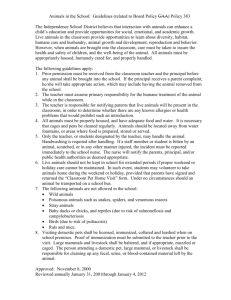Animal Use Protocol - VPRED
advertisement

Animal Use Protocol University of Arkansas, Fayetteville Coversheet IACUC use only: Protocol number: Date Received: Approval Date: Start Date: End Date: Category(s) of animal use: Agricultural Biomedical Field LATA Training Verified Yes No Instructions: This is a MicroSoft Word (MSWord) “form”. Use MSWord to fill in the information asked for in either the blanks (“____”), or the box (“ “) provided. You can put as much information in the blanks or boxes as needed. (Note -- It may cause minor complications to use the “Tab” key to move from box to box since the boxes are a cell in a table [consisting of one cell]. Therefore, it should cause less problems to avoid using the tab key. However, if you need to use the Tab key in the cell, you will need to use the Ctrl-Tab combination.) Submit an electronic copy of your completed protocol to iacuc@uark.edu and be sure to sign the appropriate form(s) with a scanned signature. However, completed forms sent in via uark.edu mail system are considered “signed” even without a scanned signature. Failure to follow these instructions and adequately fill out the required information may result in the protocol being returned. The deadline for getting this form to Tony Munn, is 12:00 Noon on Monday of the week of the IACUC meeting when it will be acted upon. Project Title: Project length (3 years maximum): Start date: End date: Principal Investigator: Co-Investigator(s) (if applicable): Name: Department/Division: Campus Mail Address: Telephone: Fax: E-mail: Individual(s) responsible for animal care: Name: Office address: Office City, State, Zip: Office phone: Home address: Home City, State, Zip: Home phone: Individual(s) responsible for euthanasia: Name: Office address: Office City, State, Zip: Office phone: Home address: Home City, State, Zip: Home phone: Document1 Rev. 01/14ruff Page 1 of 11 Animal Use Protocol University of Arkansas, Fayetteville Coversheet Animals used Species: Common name: Calculated number to be used (by species; not a combined number): -- Note: This number (or these numbers) must agree with those listed in Section 2B (Experimental Design) of the Narrative. Supplier (all purchases must be from a licensed supplier) Name: Address: Locations (building and room) Animal housing: Surgical facility: Data collection: Document1 Rev. 01/14ruff Page 2 of 11 Animal Use Protocol University of Arkansas, Fayetteville Checklist Title of Project: Principal Investigator: Type of Project: Select one Research Teaching Course Number(s) Category of research and teaching for which this protocol was written: Select one Biomedical Agricultural Field Funding Source (check all that apply): NIH NSF USDA private industry U of A State of Arkansas other (identify): Level of Pain or Stress: Check only one level, which should be the most severe level the animals will be subjected to during the course of the study (Please read these carefully) Level Level 1 Level 2 Level 3 Examples and Comments Level 1 Experiments on vertebrate animals that are expected to produce little or no discomfort. Simple procedures such as injections and blood sampling; observational field behavior; physical examinations; experiments on anesthetized animals that do not regain consciousness; food/water deprivation for short periods and methods of euthanasia that induce rapid unconsciousness. Level 2 Experiments that involve some minor stress or shortduration pain to vertebrate animals. With anesthesia, "cut downs" or implantation of catheters; behavioral experiments on conscious animals that involve restraint; immunization employing Freund's adjuvant; noxious stimuli from which escape is possible; surgical procedures under anesthesia that may result in postsurgical discomfort (possibly requiring analgesics); Level 3 Experiments that involve significant unavoidable stress or pain to vertebrate animals. experimental infection Deliberate induction of behavioral stress; major surgical procedures under anesthesia that result in significant postoperative discomfort or an anatomic or physiologic deficit that will result in pain or distress; noxious stimuli from which escape is impossible; prolonged periods of physical restraint; procedures that produce pain or distress in which anesthetics are not used (toxicity testing, radiation sickness, certain injections, stress and shock producing no significant pain or distress. experimental infection producing systemic disease that will result in pain, distress, or death). research, or Level 3 mandates responsibility on the part of the investigator to explore alternative procedures. Level 4 Level 4 Procedures that involve inflicting severe pain on unanesthetized, conscious animals. Use of muscle relaxants or paralytic drugs without the use of anesthetics; surgery, severe burn or trauma infliction on unanesthetized animals; attempts to induce psychotic-like behavior or severe stress or terminal stress. Many of these procedures are specifically prohibited and therefore may result in withdrawal of federal funds and/or institutional USDA registration. Note: The preceding levels correspond to the following animal use categories on the APHIS annual report form: Level 1 = Category C or D; Level 2 = Category D; Levels 3 and 4 = Category E. Document1 Rev. 01/14ruff Page 3 of 11 Animal Use Protocol University of Arkansas, Fayetteville Checklist Surgical Procedures: If any of the methods/techniques listed below will be used, check the appropriate space and provide the requested details in Section 2D of the Narrative (Surgical Procedures): none non-survival surgery (euthanasia will be administered before recovery from anesthesia) survival surgery (animal will be allowed to recover from anesthesia) multiple survival surgeries (this requires explicit justification in Narrative) Non-Surgical Procedures: If any of the methods/techniques listed below will be used, check the appropriate space and provide the requested details in Section 2C of the Narrative (Non-Surgical Procedures): Non-surgical invasive procedures (blood collection, catheterization, intubation, etc.). Provide appropriate details (volume, site, frequency, etc.) Exposure of a living animal to a hazardous, toxic, and/or radioactive substance. Provide substance name, route of administration, dose, volume, frequency Exposure of a living animal to an infectious agent. Notice, if this is checked, you must also check, either Level 2 or Level 3 pain in the previous section! Provide name of agent, means of exposure, and amount and frequency of exposure. Specify in “Method of Euthanasia” section, the criterion you will use to determine if euthanasia is necessary to relieve suffering. Immunization protocol. Provide name of adjuvant(s) used; injection site; volume per site; frequency of injection; method, frequency, and volume of blood withdrawn (including anesthetic, if used). Note: this does NOT apply to standard prophylactic vaccinations. Prolonged restraint. Provide method, duration, frequency, procedure by which animal is adapted to restraint device. Food/water deprivation. Provide duration, frequency, extent (total/partial), methods used to assess and monitor distress. Note: removal of food and/or water for 24 hours in preparation for surgery or some other procedure is NOT considered to be food/water deprivation. Abnormal environment. Provide information on departure from normal conditions (temperature, humidity, light, duration, etc.). Aversive stimuli. Provide type and intensity of stimulus, duration, justification for use. Hybridoma protocol. Provide priming agent, cells injected, schedule for collection of ascites, number of abdominal taps, size of needle used. Important: Provide justification for use of the in vivo mouse ascites method versus the various in vitro methods currently available, providing adequate documentation. Use of neuromuscular blocking agents (muscle paralytics) during surgery. Provide a rationale for their use and explain how you will determine that adequate anesthesia is maintained. Use of death (without euthanasia) as an endpoint of the study. Provide justification why an earlier endpoint is not acceptable. Document1 Rev. 01/14ruff Page 4 of 11 Animal Use Protocol University of Arkansas, Fayetteville Checklist Method of Euthanasia -- Identify the method(s) of euthanasia to be used; it (they) must comply with the most recent AVMA Guidelines on Euthanasia http://www.avma.org/issues/animal_welfare/euthanasia.pdf none needed overdose of anesthetic (specify agent, dose, and route of administration) inhalation of carbon dioxide physical means under general anesthesia (identify the specific means that will be used; cervical dislocation, etc.) physical means without anesthesia the use of captive bolt pistol on large farm animals, cervical dislocation on chickens, and some other physical methods [such as gunshot] are permitted, if done properly by trained personnel; OTHERWISE, physical means without anesthesia (such as cervical dislocation of mice) can be used only when scientifically justified and requires specific written justification). If to be used, write justification here: other (identify here and describe): Disposal of remains: Incineration at University Farm (this is the disposal site for dead animals that are placed in the freezer at CLAF) Other (describe): Document1 Rev. 01/14ruff Page 5 of 11 Animal Use Protocol University of Arkansas, Fayetteville Narrative 1. ABSTRACT (approximately 100-300 words) Please provide, in lay language, a concise but specific statement of the scientific objective for the proposed research, the rationale behind this objective, the species of animal to be used, and an overview of the procedures to be followed. This statement should stand alone and be comprehensible to a non-scientist. This is NOT the place for a lengthy introduction! PLEASE… Abstract here : 2. METHODS Using the headings listed below, describe the methods to be used in your project. The level of detail for procedures involving animals should be comparable to that in the Methods section of a journal article (i.e., sufficient to enable another researcher competent in your field to replicate your study). Please, do not cut & paste from your grant proposal, it usually includes information that the IACUC does not need to review. Also, do not repeat information in the different sections below any more than is absolutely necessary to communicate clearly what you plan to do. (In other words, do not repeat descriptions in B, C, and/or D.) A. Housing (Note: Cage size, amount of room per animal, etc. must conform to the dimensions listed in one of the following; ILAR Guide for the Care and Use of Laboratory Animals, Animal Welfare Act (USDA) Regulations, PHS Policy on Humane Care and Use of Laboratory Animals, or FASS GUIDE For the Care and Use of Agricultural Animals in Agricultural Research and Teaching. The only exceptions are those protocols that are to be done under “commercial conditions”, these must be appropriately documented and approved.) Describe how the animals will be housed, including cage or pen size (indicate dimensions), number per cage where applicable (indicating area of floor space allotted to each animal), and a concise description of routine husbandry practices Describe here : B. Experimental design Provide an overview of the experimental design, including: numbers of groups (include some sort of table, list, chart, etc., indicating treatment groups, etc.) Tables listing groups with respective treatments and numbers of animals/group are extremely useful numbers of animals in each group (Note: These numbers must agree with the number listed on the Coverpage) a schedule or timetable of the treatments animals will be exposed to duration of treatments the terminal fate of the animals (sent to processing, subjected to a terminal procedure under anesthesia, euthanized for tissue collection, etc.) Describe here : Document1 Rev. 01/14ruff Page 6 of 11 Animal Use Protocol University of Arkansas, Fayetteville Narrative C. Non-surgical procedures involving animals Be particularly detailed regarding any procedures that are: invasive, involve stress, or cause tissue damage. Be sure this section explains (and agrees with) what is indicated on the Checklist. Describe here : D. Surgical procedures Note: Written records of surgery and anesthesia must be kept for each animal. Animals must be observed daily following surgery and observations must be recorded from the time surgery is completed until incisions are healed. These records must be made available for semi-annual inspection by the IACUC. Be sure this section explains what is indicated on the Checklist. 1. Surgeon(s) (list his or her qualifications for the doing the procedures to be carried out) List here : 2. Procedure (must use aseptic techniques) Describe here : 3. Medication For all medications, specify: agent, route of administration (e.g., IM), dose (indicate mg of drug/kg of body wt. and also include both concentration of the drug being used [usually expressed as mg of drug/ml of solution] and ml of solution/kg of body wt. to be given) frequency of administration (when appropriate) Document1 Rev. 01/14ruff A. Pre-operative medication and preparation Describe here : B. Anesthesia and other medication during surgery Describe here : C. Post-operative medication and observation Describe here : Page 7 of 11 Animal Use Protocol University of Arkansas, Fayetteville Narrative E. Euthanasia If animals to become seriously ill or injured (even if this is not an expected occurrence), specify the criterion you will use to determine if, and when euthanasia will be used to relieve suffering. If euthanasia is not included as part of the protocol, indicate what will happen to the animals at the end of the study. Again, information included should conform to what is indicated on the Checklist. Describe here : 3. QUALIFICATIONS OF INDIVIDUALS PERFORMING WORK WITH ANIMALS Please list all individuals who will be carrying out procedures involving animals during this project. Please indicate who will be performing each procedure and their qualifications for that procedure. If individuals are to be trained in a procedure during this project, please indicate who will provide the training and supervision and their qualifications. A. Principal Investigator (a current vita should be on file with the IACUC) Any Additional Information here : B. Students (attach resume or provide a brief description of qualifications) Any Additional Information here : C. Lab Technicians (attach resume or provide a brief description of qualifications) Any Additional Information here : D. Individuals Providing Training or Supervision (attach resume or provide a brief description of qualifications) Any Additional Information here : All personnel listed on this protocol must complete the 2 base modules; (1) The Humane Care and Handling of Laboratory Animals and (2) Policy and Procedures, of the Laboratory Animal Training Association (LATA) online training program. Any questions regarding this training should be directed to Tony Munn (575-2994 or iacuc@uark.edu). Please fill out the table on the following page regarding the completion of this training. Document1 Rev. 01/14ruff Page 8 of 11 Animal Use Protocol University of Arkansas, Fayetteville Narrative LATA Training Documentation Person: List Names Responsibility – PI, Tech, Student, or Other Required Modules: Base Modules The Humane Care and Use of Laboratory Animals Policy and Procedures PI T S O PI T S O PI T S O PI T S O PI T S O PI T S O PI T S O PI T S O PI T S O PI T S O PI T S O PI T S O PI T S O PI T S O Date Completed Date Completed Optional Modules: Species Modules The Humane Care and Use of the Laboratory Rat The Humane Care and Use of the Laboratory Mouse The Humane Care and Use of the Laboratory Hamster The Humane Care and Use of the Laboratory Guinea Pig The Humane Care and Use of the Laboratory Rabbit The Humane Care and Use of the Laboratory Goat The Humane Care and Use of Laboratory Swine The Humane Care and Use of Laboratory Fish Techniques Modules Aseptic Surgery of Rodents Anesthesia and Analgesia of Rodents Safety Module Occupational Health and Safety Person: Date Completed Date Completed Date Completed Date Completed Date Completed Date Completed Date Completed Date Completed Date Completed Date Completed Date Completed List Names Responsibility – PI, Tech, Student, or Other Required Modules: Base Modules The Humane Care and Use of Laboratory Animals Policy and Procedures Date Completed Date Completed Optional Modules: Species Modules The Humane Care and Use of the Laboratory Rat The Humane Care and Use of the Laboratory Mouse The Humane Care and Use of the Laboratory Hamster The Humane Care and Use of the Laboratory Guinea Pig The Humane Care and Use of the Laboratory Rabbit The Humane Care and Use of the Laboratory Goat The Humane Care and Use of Laboratory Swine The Humane Care and Use of Laboratory Fish Techniques Modules Aseptic Surgery of Rodents Anesthesia and Analgesia of Rodents Safety Module Occupational Health and Safety Document1 Rev. 01/14ruff Date Completed Date Completed Date Completed Date Completed Date Completed Date Completed Date Completed Date Completed Date Completed Date Completed Date Completed Page 9 of 11 Animal Use Protocol University of Arkansas, Fayetteville Assurance Statements for Biomedical Research and Teaching 4. STATEMENT OF COMPLIANCE: As the individual responsible for this research or teaching project, I confirm that the information contained herein is accurate and, to the best of my knowledge, conforms to all applicable University, PHS, and USDA policies on the use of animals in research and teaching. I confirm that I have completed the following online LATA training modules: 1) The Humane Care and Use of Laboratory Animals, 2) Policy and Procedures. I confirm that all individuals involved with the animals used in this project will complete the above online LATA training modules and will be instructed in the humane care, handling, and use of animals, prior to participation in the project, and I will have reviewed their qualifications. I agree not to proceed with any portion of this project or purchase animals until I receive written approval from the University of Arkansas Institutional Animal Care and Use Committee (IACUC). I agree that no substantive change will be made in the procedures contained in this proposal without prior written notification to and approval by the IACUC. I agree to allow inspection of my research facilities by members of the IACUC and the Animal Welfare Veterinarian and to comply promptly if informed of any violations of the University of Arkansas, Fayetteville's Policy on Animal Care and Use. I understand that failure to comply with the University of Arkansas, Fayetteville's Policy on Animal Care and Use will jeopardize the University's Animal Welfare Assurance on file with the PHS (and with it all federal funding for the University), and may ultimately lead to revocation of my privileges to conduct animal research at the University of Arkansas. (place a scanned signature in the box ↑) Signature of Principal Investigator: Date: Assurance Statement of Compliance Document1 Rev. 01/14ruff Page 10 of 11 Animal Use Protocol University of Arkansas, Fayetteville Assurance Statements for Biomedical Research and Teaching DO NOT COMPLETE THIS SECTION IF PROTOCOL IS SPECIFIED AS AGRICULTURAL or FIELD RESEARCH The regulations for the Animal Welfare Act (United States Department of Agriculture) and the Public Health Service require that protocols for biomedical research and teaching involving animals the following concerns be specifically addressed in writing by the Principal Investigator. Items in brackets [] identify the source of the requirement [AWA = Animal Welfare Act regulations; NIH = NIH Guide for Care and Use of Laboratory Animals, 1996 edition]. A. Animals should not be used if other methods exist that would provide substantially the same information. Indicate why the use of live animals is required in this research. [AWA 2.31 (e) (2); NIH p. 8] : Indicate here : B. Justify your choice of species by listing some of the important characteristics of the species that make it suitable for use in the proposed research. Cost alone is not sufficient rationale. [AWA 2.31 (e) (2); NIH p. 8] : Justify here : C. The number of animals used should be the minimum number that can be expected to provide valid results. Describe how the number of animals to be used was determined to comply with this requirement, i.e., that the number animals to be used can be expected to provide valid results. [AWA 2.31 (e) (2); NIH p. 8] : A statistical explanation is needed. Describe here : D. The principal investigator submitting protocols for biomedical research should not unnecessarily duplicate previous experiments, and must consider less invasive alternatives to procedures that may cause more than momentary or slight pain or distress to animals (i.e., Level 3 or higher). Provide a statement that a literature review has been carried out demonstrating that this research does not unnecessarily duplicate previous experiments, and that appropriate alternative research methods are not available for any proposed procedures that are Level 3 or higher. The database used must be identified (check below). [AWA 2.31 (d) (1) (I, ii, and iii); NIH p. 8] : (Note, this requirement does not apply to protocols for teaching projects.) Provide statement here : (Be sure to list date(s) of search for each database used and the keywords that were used.) Database Medline Agricola Index Medicus Biol. Abstracts Animal Welfare Information Center Date(s) of Search Key Words Used (National Agricultural Library) Other (please specify below): ↑) Signature of Principal Investigator Date: Assurance Statement for Biomedical Research (place a scanned signature in the box Document1 Rev. 01/14ruff Page 11 of 11







